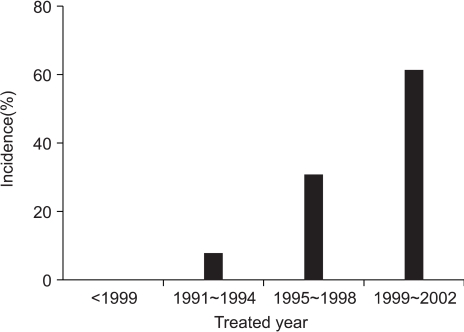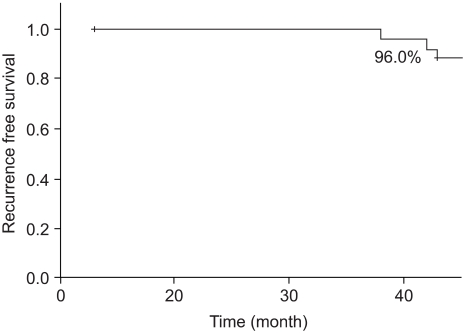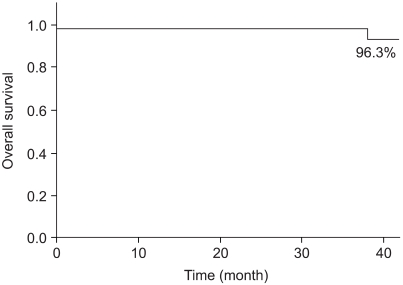Cancer Res Treat.
2005 Dec;37(6):344-348.
Clinical Experience of Patients with Ductal Carcinoma In Situ of the Breast Treated with Breast-Conserving Surgery plus Radiotherapy: A Preliminary Report
- Affiliations
-
- 1Department of Radiation Oncology, Chosun University Hospital, Gwangju, Korea.
- 2Department of Radiation Oncology, Chonbuk University Hospital, Jeonju, Korea.
- 3Department of Radiation Oncology, College of Medicine, The Catholic University of Korea, Seoul, Korea. sumic@catholic.ac.kr
- 4Department of Surgery, College of Medicine, The Catholic University of Korea, Seoul, Korea.
Abstract
- PURPOSE
Breast-conserving therapy (BCT) is a practical alternative to mastectomy for treating ductal carcinoma in situ (DCIS). We reviewed our experience for treating patients with DCIS of the breast to evaluate the outcome after performing breast-conserving surgery plus radiotherapy (BCS-RT). MATERIALS AND METHODS: Between January 1983 and December 2002, 25 patients with clinically or mammographically detected DCIS were treated by BCS-RT. One patient was diagnosed with bilateral DCIS. Thirteen cases (50%) had symptomatic lesions at presentation. All 26 cases of 25 patients underwent BCS such as lumpectomy, partial mastectomy or quadrantectomy. All of them received whole breast irradiation to a median dose of 50.4 Gy. Twenty-four cases (92.3%) received a boost to the tumor bed for a median total dose of 59.4 Gy. The median follow up period was 67 months (range: 38 to 149 months). RESULTS: Two cases (7.7%) experienced ipsilateral breast tumor recurrence (IBTR) after BCS-RT. The histology results at the time of IBTR showed invasive ductal carcinoma (IDC), and the median time to IBTR was 25.5 months. On the univariate analysis, there were no significant factors associated with IBTR in the DCIS patients. The three-year local recurrence free survival rate was 96.0% and the overall survival rate was 96.3%. CONCLUSION: After the treatment for DCIS, the IBTR rate in our study was similar to other previous studies. Considering that we included patients who had many symptomatic lesions, close or positive margins and less that complete early data, our result is comparable to the previous studies. We could not find the prognostic significant factors associated with IBTR after BCS-RT. A longer follow up period with more patients would be required to evaluate the role of any predictive factors and to confirm these short-term results.
MeSH Terms
Figure
Reference
-
1. Ernster VL, Barclay J, Kerlikowske K, Grady D, Henderson C. Incidence and treatment for ductal carcinoma in situ of the breast. JAMA. 1996; 275:913–918. PMID: 8598618.2. Verkooijen HM, Fioretta G, De Wolf C, Vlastos G, Kurtz J, Borisch B, et al. Management of women with ductal carcinoma in situ of the breast: a population-based study. Ann Oncol. 2002; 13:1236–1245. PMID: 12181247.
Article3. Kricker A, Armstrong B. Surgery and outcomes of ductal carcinoma in situ of the breast: a population-based study in Australia. Eur J Cancer. 2004; 40:2396–2402. PMID: 15519511.
Article4. Kessar P, Perry N, Vinnicombe SJ, Hussain HK, Carpenter R, Wells CA. How significant is detection of ductal carcinoma in situ in a breast screening programme. Clin Radiol. 2002; 57:807–814. PMID: 12384106.
Article5. Kestin LL, Goldstein NS, Martinez AA, Rebner M, Balasubramaniam M, Frazier RC, et al. Mammographically detected ductal carcinoma in situ treated with conservative surgery with or without radiotherapy: patterns of failure and 10-year results. Ann Surg. 2000; 231:235–245. PMID: 10674616.6. Vicini FA, Lacerna MD, Goldstein NS, Horwitz EM, Dmuchowski CF, White JR, et al. Ductal carcinoma in situ detected in the mammographic era: an analysis of clinical, pathologic, and treatment-related factors affecting outcome with breast-conserving therapy. Int J Radiat Oncol Biol Phys. 1997; 39:627–635. PMID: 9336142.
Article7. Lee JM, Paik NS, Kim YK, Moon NM, Lee JI, Choi DW, et al. Clinical analysis of ductal carcinoma in situ of the breast. J Korean Cancer Assoc. 1995; 27:822–828.8. Oh ST, Jung SS, Kim IM, Kim IC. Ductal carcinoma in situ. J Korean Cancer Assoc. 1994; 26:576–581.9. Cancer prevalence statistics. 23th Korean Cancer Registry Report. 2002. National Cancer Center.10. Silverstein MJ, Barth A, Poller DN, Gierson ED, Colburn WJ, Waisman JR, et al. Ten-year results comparing mastectomy to excision and radioation therapy for ductal carcinoma in situ of the breast. Eur J Cancer. 1995; 31A:1425–1427. PMID: 7577065.11. Fisher B, Constantino J, Redmond C, Fisher E, Margolese R, Dimitrov N, et al. Lumpectomy compared with lumpectomy and radiation therapy for the treatment of intraductal breast cancer. N Engl J Med. 1993; 328:1581–1586. PMID: 8292119.
Article12. Fisher B, Land S, Mamounas E, Dignam J, Fisher ER, Wolmark N. Prevention of invasive breast cancer in women with ductal carcinoma in situ: an update of the National Surgical Adjuvant Breast and Bowel Project Experience. Semin Oncol. 2001; 28:400–418. PMID: 11498833.
Article13. Julien JP, Bijker N, Fentiman IS, Peterse JL, Delledonne V, Rouanet P, et al. Radiotherapy in breast conserving treatment for ductal carcinoma in situ: first results of the EORTC randomized phase III trial 10853. Lancet. 2000; 355:528–533. PMID: 10683002.14. Silverstein MJ, Lagios MD, Groshen S, Waisman JR, Lewinsky BS, Martino S, et al. The influence of margin width on local control of carcinoma in situ of the breast. N Engl J Med. 1999; 340:1455–1461. PMID: 10320383.15. Park HB, Lee HD, Jung WH, Chi HS, Kim BR, Min JS. Ductal carcinoma in situ of the breast. J Korean Cancer Assoc. 1993; 25:905–911.16. Vicini FA, Kestin LL, Goldstein NS, Chen PY, Pettigna J, Frazier RC, et al. Impact of young age on outcome in patients with ductal carcinoma in situ treated with breast conserving therapy. J Clin Oncol. 2000; 18:296–306. PMID: 10637243.17. Fowble B, Hanlon AL, Fein DA, Hoffman JP, Sigurdson ER, Patchefsky A, et al. Results of conservative surgery and radiation for mammographically detected ductal carcinoma in situ (DCIS). Int J Radiat Oncol Biol Phys. 1997; 38:949–957. PMID: 9276359.
Article18. Jhingran A, Kim JS, Buchholz TA, Katz A, Strom EA, Hunt KK, et al. Age as a predictor of outcome for women with DCIS treated with breast-conserving surgery and radiation: the University of Texas M. D. Anderson Cancer Center Experience. Int J Radiat Oncol Biol Phys. 2002; 54:804–809. PMID: 12377332.
Article19. Vargas C, Kestin L, Go N, Krauss D, Chen P, Goldstein N, et al. Factors associated with local recurrence and cause specific survival in patients with ductal carcinoma in situ of the breast treated with breast-conserving therapy or mastectomy. Int J Radiat Oncol Biol Phys. 2005; 63:1514–1521. PMID: 16005576.20. Roka S, Rudas M, Taucher S, Dubsky P, Bachleitner-Hofmann T, Kandioler D, et al. High nuclear grade and negative estrogen receptor are significant risk factors for recurrence in DCIS. Eur J Surg Oncol. 2004; 30:243–247. PMID: 15028303.
Article21. Thurman SA, Schnitt SJ, Connolly JL, Gelman R, Silver B, Harris JR, et al. Impact of surgery-to-radiotherapy interval (SRI) on local control in patients with ductal carcinoma in situ (DCIS) treated with breast conserving therapy (BCT). Int J Radiat Oncol Biol Phys. 2004; 60:S382.22. Fisher B, Dignam J, Wolmark N, Lawrence WD, Fisher ER, Mamounas E, et al. In DCIS patients, the combination of lumpectomy and radiotherapy with tamoxifen improves the prevention of invasive breast cancer. Evid Oncol. 2000; 1:25–26.23. Holmes DR, Buchanan C, Alleyne R, Nakamura SK, Silberman H, Waisman JR, et al. Nonpalpable breast carcinoma: superior survival when compared with palpable breast cancer. Breast Cancer Res Treat. 2005; 76S:S148.24. Skinner KA, Silberman H, Sposto R, Silvertein MJ. Palpable breast cancers are inherently different from nonpalpable breast cancers. Ann Surg Oncol. 2001; 8:705–710. PMID: 11597010.
Article25. Kim KJ, Huh SJ, Park W, Yang JH, Nam SJ, Kim JH, et al. Treatment outcome and analysis of the prognostic factors of ductal carcinoma in situ treated with breast conserving surgery and radiotherapy. J Korean Soc Ther Radiol Oncol. 2004; 22:11–16.
- Full Text Links
- Actions
-
Cited
- CITED
-
- Close
- Share
- Similar articles
-
- Radiotherapy for Breast Cancer
- Ductal Carcinoma In Situ of the Breast Arising in Microglandular Adenosis
- Apocrine Ductal Carcinoma In Situ of the Breast Presented Mass with Morphological Change on Follow-Up Ultrasound: A Report of Case
- Clinical Outcomes of Ductal Carcinoma In Situ of the Breast Treated with Partial Mastectomy without Adjuvant Radiotherapy
- Invasive Lobular Carcinoma of the Breast Associated with Mixed Lobular and Ductal Carcinoma In Situ: A Case Report




